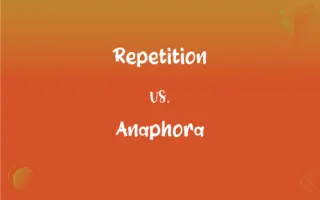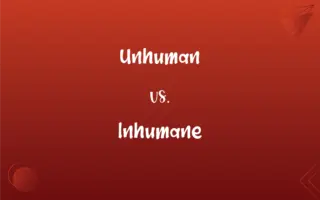Hanja vs. Kanji: What's the Difference?
By Harlon Moss || Updated on May 22, 2024
Hanja refers to the Korean adaptation of Chinese characters, primarily used in historical texts, while Kanji is the Japanese system of writing using Chinese characters, commonly used in modern Japanese writing alongside hiragana and katakana.

Key Differences
Hanja are Chinese characters used in the Korean language, primarily for historical texts and academic writing. They were more prevalent before the creation of Hangul, the Korean alphabet, in the 15th century. Kanji, on the other hand, are Chinese characters used in the Japanese writing system. Unlike Hanja, Kanji are integral to modern Japanese writing, appearing alongside hiragana and katakana.
Hanja characters often share the same form as their Chinese counterparts but may have different pronunciations and sometimes meanings. The use of Hanja has decreased significantly in Korea since the 20th century due to the rise of Hangul. Kanji characters also derive from Chinese characters, but their pronunciations and meanings can differ from both their Chinese and Korean counterparts. Kanji is still a critical component of literacy in Japan, with children learning around 2,000 Kanji characters during their schooling to be fully literate.
The education systems in Korea and Japan differ significantly regarding these characters. In Korea, Hanja education is not emphasized in the general curriculum, whereas in Japan, learning Kanji is a fundamental part of the educational process. This difference highlights the varying degrees of importance placed on these characters in contemporary Korean and Japanese societies.
Comparison Chart
Language
Korean
Japanese
Usage
Historical texts, names, scholarly work
Everyday writing, literature, official documents
ADVERTISEMENT
Prevalence
Rarely used in modern writing
Commonly used in modern writing
Education
Limited emphasis in schools
Integral part of the curriculum
Characters
Same form as Chinese characters but with different pronunciations
Derived from Chinese characters with unique pronunciations
Hanja and Kanji Definitions
Hanja
Historical and scholarly Korean texts.
The scholar read ancient texts written in Hanja.
Kanji
Characters representing words or morphemes.
The Kanji for tree is 木.
ADVERTISEMENT
Hanja
Chinese characters used in Korean.
Hanja is often seen in Korean historical documents.
Kanji
Used alongside hiragana and katakana.
Japanese writing combines Kanji, hiragana, and katakana.
Hanja
Limited use in modern Korean writing.
Hanja is not commonly taught in Korean schools today.
Kanji
Integral to modern Japanese writing.
Japanese students learn Kanji from an early age.
Hanja
Characters borrowed from Chinese.
The word school in Hanja is written as 學校.
Kanji
Chinese characters used in Japanese.
Kanji is an essential part of the Japanese writing system.
Hanja
Used for clarity and names.
Hanja is sometimes used in Korean newspapers for disambiguation.
Kanji
Important for Japanese literacy.
Knowing Kanji is crucial for reading Japanese literature.
Hanja
The Han character script used to write Korean, particularly in classical literature. Compare hangeul, the Korean phonetic script.
Kanji
A Japanese system of writing based on borrowed or modified Chinese characters.
Kanji
A character used in this system of writing.
Kanji
(uncountable) The system of writing Japanese using Chinese characters.
Japanese is written in a mixture of kanji and kana.
Kanji
Any individual Chinese character as used in the Japanese language.
I know about a thousand kanji.
Kanji
A North Indian fermented drink made with beetroot and carrots.
FAQs
How do Hanja and Kanji differ in usage?
Hanja is rarely used in modern Korean writing, while Kanji is widely used in Japanese writing.
What is Kanji?
Kanji are Chinese characters used in the Japanese writing system, integral to modern Japanese literacy.
What is Hanja?
Hanja refers to Chinese characters used in the Korean language, mainly in historical and scholarly contexts.
Do Hanja and Kanji characters look the same?
Many Hanja and Kanji characters look the same but may have different pronunciations and meanings.
How are Hanja and Kanji similar?
Both Hanja and Kanji are derived from Chinese characters and share similar forms.
Why is Hanja less common in modern Korea?
The creation and adoption of Hangul reduced the reliance on Hanja in Korea.
Is it necessary to learn Hanja to be fluent in Korean?
No, modern Korean fluency primarily requires knowledge of Hangul, though Hanja can be helpful for historical texts.
Is Kanji still taught in Japanese schools?
Yes, Kanji is a fundamental part of the Japanese educational curriculum.
Can a Korean speaker understand Kanji?
A Korean speaker familiar with Hanja may recognize some Kanji characters but might not understand their Japanese pronunciations or meanings.
What was used in Korea before Hangul?
Before Hangul, Koreans primarily used Hanja for writing.
Why do Japanese use three writing systems?
Japanese uses Kanji, hiragana, and katakana to differentiate word types and add clarity and nuance to the language.
How do students in Japan learn Kanji?
Japanese students learn Kanji through continuous education from elementary school to high school.
How many Kanji characters are commonly used in Japanese?
About 2,000 Kanji characters are commonly used and taught in Japanese schools.
Are there any official documents written in Hanja?
Official documents in Korea are typically written in Hangul, with Hanja occasionally used for clarification.
Do Hanja characters have different meanings in Korean and Chinese?
Some Hanja characters may have different meanings or usages in Korean compared to Chinese.
How are Kanji characters pronounced?
Kanji characters can have multiple readings and pronunciations depending on their context in Japanese.
Can Hanja be used in modern Korean names?
Yes, Hanja is still used in Korean names for clarity and tradition.
Can Japanese text be written without Kanji?
Japanese text can be written without Kanji, using only hiragana and katakana, but it would be less efficient and harder to read.
Are Hanja characters still taught in Korean schools?
Hanja education is limited in Korean schools, with more emphasis on Hangul.
Is Kanji more complex than Hanja?
Kanji can be seen as more complex due to its multiple readings and integration with hiragana and katakana in the Japanese language.
About Author
Written by
Harlon MossHarlon is a seasoned quality moderator and accomplished content writer for Difference Wiki. An alumnus of the prestigious University of California, he earned his degree in Computer Science. Leveraging his academic background, Harlon brings a meticulous and informed perspective to his work, ensuring content accuracy and excellence.































































